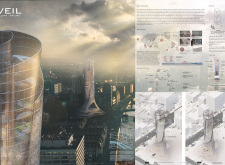5 key facts about this project
The skyscraper design focuses on tackling the significant issue of plastic waste in urban areas. Positioned in a location where waste can be effectively processed, it combines practical functions with a visual statement about sustainability. The goal is to engage the community and change how people view and manage plastic usage.
Facade and Visual Connection
The building's exterior serves two main purposes: it acts as a temporary storage area for plastic waste and integrates green spaces into the design. This combination highlights the importance of environmental responsibility in urban settings. The facade will change over time, beginning with a display of non-degradable plastic and gradually transforming as the amount of waste decreases. This visible shift serves as a reminder of the ongoing effort to reduce plastic.
Internal Processing Capabilities
Inside the skyscraper, there are two vertical systems in place to manage different types of plastics. One area will focus on biodegradable plastics, while the other will handle non-degradable materials. This separation enhances the recycling process. Non-degradable plastics will be turned into reusable pellets, while the biodegradable waste will be composted and used as organic fertilizer for a planned vertical farm. This thoughtful approach merges waste management with urban agriculture, creating a practical and sustainable environment.
Community Interaction and Transformation
A notable aspect of the design is its potential to evolve into a green park as plastic waste is reduced. This transformation reflects a larger shift in how communities handle waste and engage with sustainability. The structure encourages participation from local residents, inviting them to take part in environmental care and awareness.
The design integrates sustainability throughout the building, allowing individuals to witness the lifecycle of waste from processing to its role in urban farming. This connection fosters a continuous conversation about environmental practices, creating a direct link between daily life, architecture, and community action. As the project develops, it aims to reflect the changing relationship between people and their environment.



















































